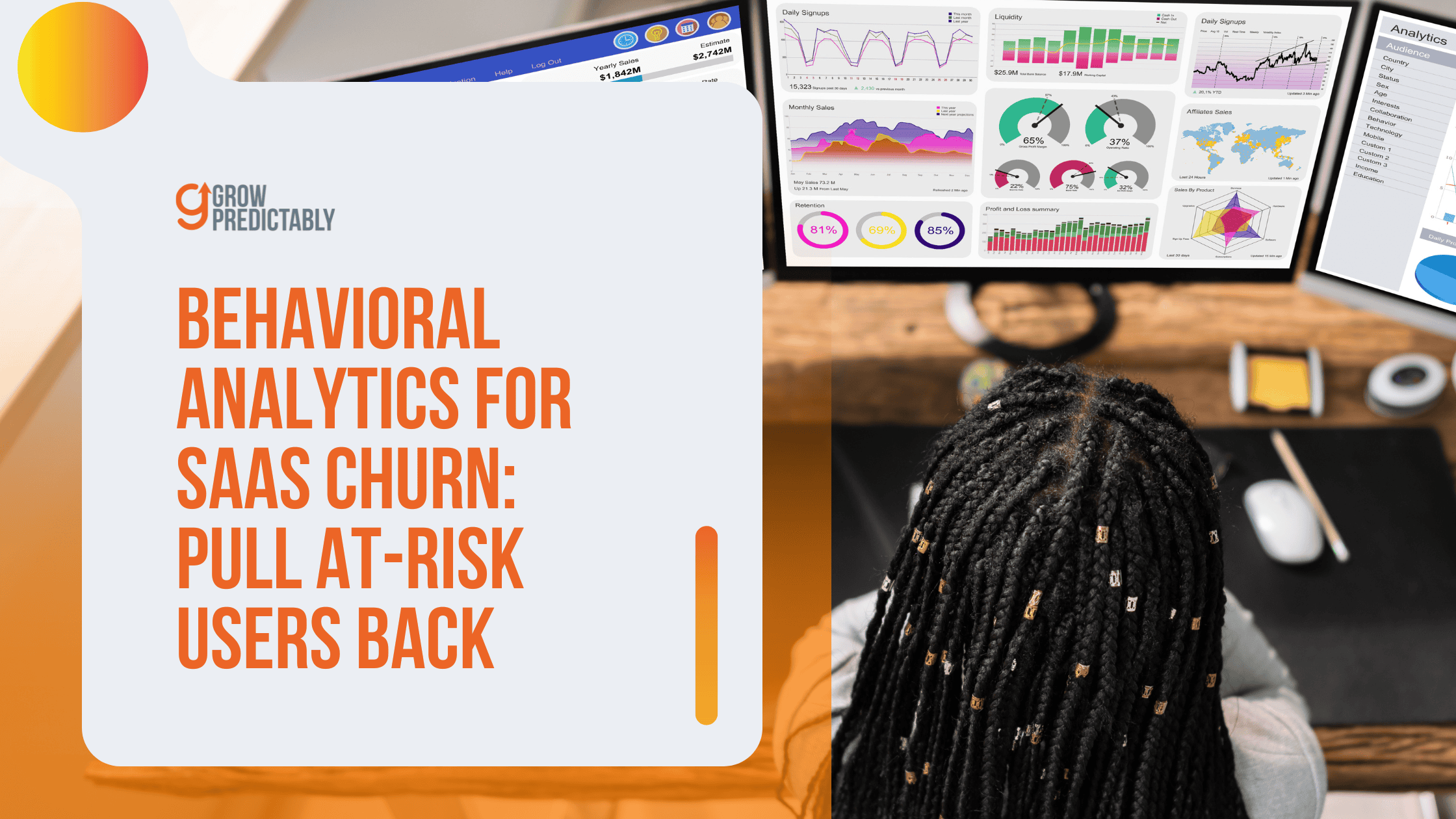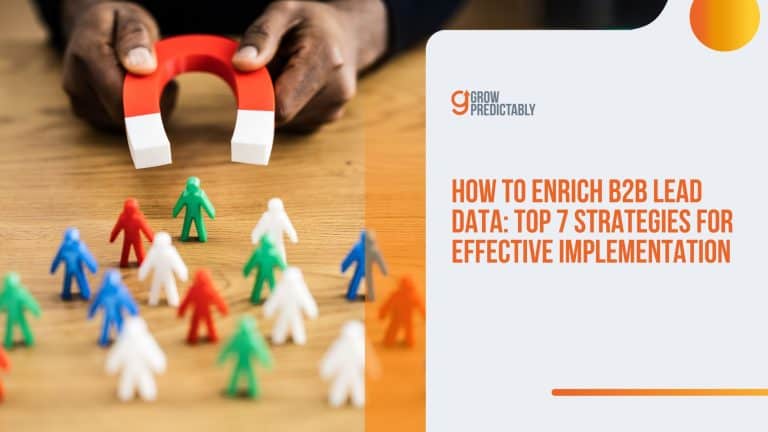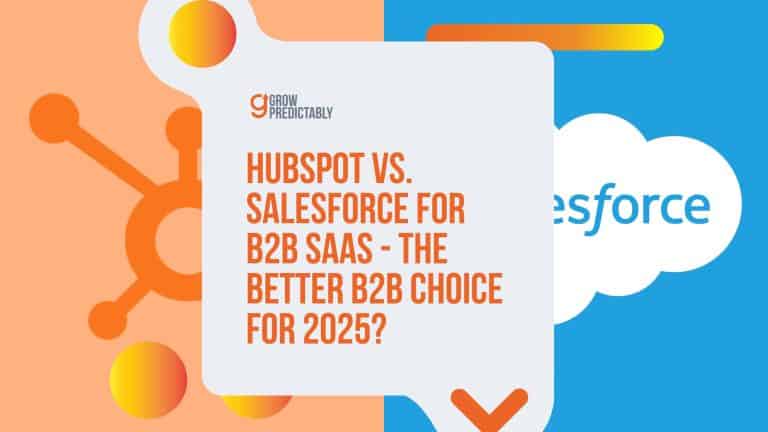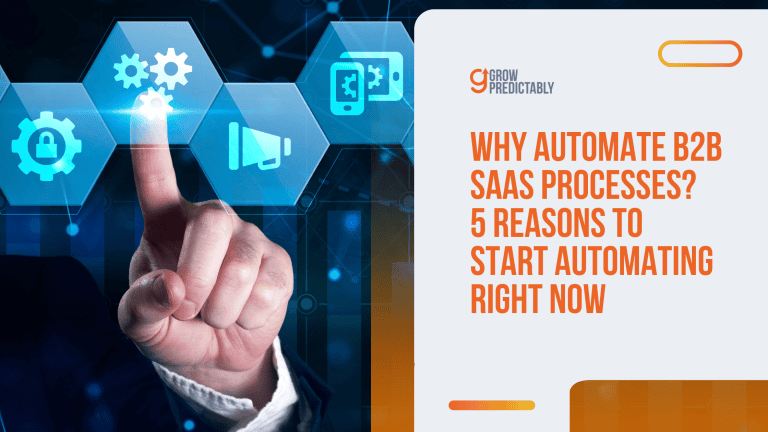Behavioral Analytics for SaaS Churn: Pull At-Risk Users Back
You’ve probably heard that reducing churn is essential for SaaS growth, but here’s the problem: most companies don’t know how to spot users who are about to leave.
Losing customers without understanding why is a recipe for disaster.
Here’s the promise: behavioral analytics can help you identify and rescue at-risk users before they churn. How?
By giving you insights into user actions that signal dissatisfaction or disengagement.
The big question is—why aren’t more SaaS companies using behavioral analytics effectively?
Let’s explore.
How Relevant is Behavioral Analytics for SaaS Churn?
Customer behavior analytics: what’s the big deal?
Simply put, it’s the ability that helps you see how your users interact with your SaaS product.
It goes beyond just tracking clicks and logins. Behavioral analytics digs deep into user actions, patterns, and habits within your platform.
Now, let’s connect the dots to churn management.
Churn or customer churn—the enemy of every SaaS business—is when customers wave goodbye and cancel their subscriptions. It’s a big problem, too.
Did you know over two-thirds of SaaS businesses experience an annual churn rate of 5% or higher? (Source)
This means that a large number of SaaS brands struggle to maintain customer retention at a desirable level.
That could potentially mean a lot of revenue walking out the door!
This is where behavioral analytics becomes your secret weapon.
By understanding how users behave, you can spot the warning signs of potential customer churn and take action before it’s too late, utilizing churn analysis to inform decisions.
Here are five ways behavioral analytics can supercharge your SaaS business growth:
- Early warning system: It helps you identify users who are at risk of churning based on their declining engagement or usage patterns.
- Personalized experiences: You can tailor your product or communications to match individual user preferences and needs.
- Feature optimization: By seeing which features are used most (or least), you can focus your development efforts where they matter most.
- Onboarding improvement: Analyze how new users interact with your product, together with customer feedback, to streamline the onboarding process and boost initial engagement.
- Upsell opportunities: Spot users who might benefit from premium features based on their current usage, improving customer satisfaction and opening doors for targeted upselling.
By leveraging behavioral analytics, you’re not just guessing what your users want or need.
You’re actively enhancing customer satisfaction and you’re making data-driven decisions that can significantly reduce churn and drive growth.
It’s a peek into your users’ needs and preferences—before they even realize them themselves, providing insights crucial for retaining existing customers.
Basically, it’s something no SaaS can afford to ignore.
Why Do Some SaaS Struggle with Behavioral Analytics?

SaaS businesses increasingly rely on behavioral analytics to understand customer interactions and prevent churn.
However, several common challenges can hinder the effectiveness of these analytics efforts:
1. Incomplete Data Integration: Often, SaaS platforms use multiple tools to gather customer data, leading to silos between marketing, sales, and customer support. Without a unified analytics platform, it becomes difficult to create a complete picture of customer behavior, resulting in fragmented insights that can’t drive coherent strategy adjustments.
2. Lack of Relevant Skills: Analyzing and interpreting data effectively requires specific skills that not all teams possess. Without expertise in data science or analytics, SaaS businesses struggle to convert raw data into actionable insights. This skills gap can lead to overlooked opportunities for enhancing user engagement and customer retention.
3. Overreliance on Basic Metrics: Some SaaS companies focus too heavily on surface-level metrics like daily active users or monthly subscription rates. While these are important, they don’t provide deep insights into customer behavior and motivations. Advanced metrics, such as user journey mapping and engagement depth, are needed to fully leverage behavioral analytics.
4. Poor Implementation of Insights: Even with the right data and skills, the final hurdle is applying these insights effectively. Some businesses fail to link analytics results with strategy evolution, meaning that despite knowing what problems exist, no solution is effectively put into practice. Turning insights into actionable strategies remains a critical step in realizing the benefits of behavioral analytics.
Addressing these challenges is crucial for SaaS companies looking to maximize the potential of behavioral analytics to enhance customer satisfaction and reduce churn.
Here’s How Data Helps You Spot SaaS Churn Early
By tracking key metrics at different stages of the customer journey, you can spot potential churners before they hit the exit button.
Let’s break it down using the Growth Scorecard framework.
The Growth Scorecard can be a crucial tool when employing behavioral analytics to mitigate churn in SaaS businesses.
This framework enables you to track key performance indicators (KPIs) at each stage of the Customer Value Journey, from initial engagement to long-term advocacy.

It’s tailored to provide actionable insights, identify bottlenecks, and facilitate data-driven decisions for strategy enhancement.
By regularly updating these KPIs, SaaS companies can swiftly pivot their strategies to address potential user drop-offs, enhancing user retention and satisfaction.
This allows you to not just react to customer churn but proactively prevent it, making your approach to customer retention both strategic and effective.
Engage Stage:
At this early stage, keep an eye on these churn-relevant KPIs:
- Time to first value
- Onboarding completion rate
- Initial feature adoption rate
Use event sequencing to analyze how quickly users reach their “aha moment.”
If it’s taking too long, they might lose interest and churn.
Create automated onboarding flows to guide users to key features faster, thus improving overall customer satisfaction early in their journey.
Subscribe Stage:
Once existing customers are in, track these metrics:
- Login frequency
- Feature usage breadth
- Customer engagement rate
Implement cohort analysis to compare user groups based on when they subscribed.
This helps you identify if certain cohorts are more likely to churn, allowing you to tailor customer retention strategies accordingly.
Convert Stage:
As users become more invested, monitor:
- Upgrade/downgrade patterns
- Support ticket frequency
- Net Promoter Score (NPS)
Use predictive modeling to forecast potential churners based on these metrics.
For example, if you notice a pattern of users downgrading before churning, create win-back campaigns offering personalized incentives to stay.
Excite Stage:
Even loyal customers can churn.
Keep track of:
- Feature usage frequency
- Account expansion rate
- Renewal likelihood score
…to assess and enhance strategies for retaining existing customers.
Also, set up inactivity triggers to automatically send re-engagement emails when usage drops.
For instance, if a power user suddenly becomes inactive, reach out with personalized tips or offer a quick consultation to address any issues.
By proactively using these metrics at each stage, you’re not just reacting to churn—you’re preventing it.
This data-driven approach allows you to make smarter, faster decisions.
REMEMBER: In SaaS, it’s not just about acquiring customers—it’s about keeping them excited and engaged for the long haul.
Behavioral analytics turns your user data into a powerful customer retention tool.
By understanding the story behind the numbers, you can create targeted strategies that pull at-risk existing customers back from the brink of customer churn, effectively lowering your overall customer churn rate.
Event Sequencing and User Journey Analysis Can Help You
Event sequencing is a powerful tool used in SaaS platforms.
It helps you track how your users interact with your platform step by step, setting the foundation for effective churn analysis.
By mapping these actions, you can see clearly how users move through different stages of their experience, from first becoming aware of your product all the way to becoming loyal promoters.
These stages are part of what we call the Customer Value Journey, which includes Awareness, Engagement, Subscription, Conversion, Excitement, Ascension, Advocacy, and Promotion.
Tracking what your users do on your platform—like when they upgrade their subscription, click on features, or complete tutorials—helps pinpoint where they might get stuck or lose interest.
This is where they might stop using your platform or churn.
Recognizing these critical points allows you to make smarter decisions about how to keep your users engaged and satisfied.
Here are some ways to use this information:
- Spotting Onboarding Issues: Maybe you notice that many users stop using your platform during the initial setup. This might mean your onboarding process is too complicated. With this insight, you can simplify these steps or offer more guidance to new users.
- Understanding Post-Subscription Customer Behavior: Let’s say your data shows that users engage less after the first month. This could be your cue to introduce new, exciting features or send out personalized messages to re-engage them.
Knowing these patterns helps you tailor your efforts to keep people around longer.
For example, if you see that a user hasn’t logged in for a while, you could automate an email that offers help or highlights new features they might be interested in.
To wrap up, aligning your strategies with how users interact with your service not only improves their experience but also helps your business thrive.
By focusing on the places where users typically drop off, you can turn potential churn into continued engagement.
Practical Strategies to Reduce Churn Using Behavioral Analytics
Reducing customer churn and keeping your users happy and engaged is a key goal for any SaaS business.
Using behavioral analytics and incorporating customer feedback, you can implement more effective strategies at each stage of the Customer Value Journey to minimize churn and increase user satisfaction.
Here is a step-by-step guide:
1. Awareness
At this initial stage, capture the user’s attention by using analytics to identify which marketing messages are resonating.
Tailor your marketing efforts to increase the relevance of your communications.
- Example: If data shows that users respond well to case studies, increase this content type to pull more potential customers into your funnel.
2. Engagement
Once users show interest, keep them engaged by analyzing their interactions and preferences.
- Example: An analytics dashboard can show which features new visitors use the most. Use this data to focus your tutorials and tips around these popular features.
3. Subscribe
When it’s time to subscribe, streamline the process based on user behavior data.
Pinpoint where prospects drop off during the sign-up process and simplify these steps.
- Example: If users hesitate at a form field asking for too much personal information, consider reducing the number of fields to lower the barrier to entry.
4. Convert
After users subscribe, analyze their actions to personalize their experiences and encourage conversion to paying customers.
- Example: Track trial usage patterns and send targeted emails suggesting the paid features that align with the activities they engaged in most during the trial.
5. Excite
Keep the excitement alive by continuously offering value.
Monitor how users interact with your product and introduce them to features they haven’t tried yet.
- Example: If a user frequently uses a basic feature, suggest a more advanced feature that offers additional benefits, using an automated email or in-app message.
6. Ascend
At the ascend stage, encourage users to upgrade or purchase additional products.
Analyze user data to offer tailored upsells or cross-sells that optimize customer lifetime value.
- Example: For users who reach their plan limits, send a personalized offer to upgrade to a higher plan with a discount incentive.
7. Advocate
Turn happy users into advocates by recognizing their loyalty.
Identify highly active users and engage them with rewards or referral programs.
- Example: Launch a campaign to reward users who have been with your service for over a year, offering them exclusive access to new features before they go public.
8. Promoter
In this final stage, empower promoters to share their positive experiences.
Analyze which existing customers are most likely to refer others and provide them with the tools to do so effectively.
- Example: Offer a referral program that makes it easy for satisfied users to invite peers and reward them with credit towards their subscription for each successful referral.
By integrating behavioral analytics at each step of the Customer Value Journey, you can create a more personalized, engaging user experience that directly tackles the reasons behind churn.
This approach not only helps in retaining your existing customers but also turns them into vocal advocates for your product, thus driving organic growth and reducing overall customer acquisition costs.
Best Practices to Effectively Leverage Data

To effectively leverage behavioral analytics in reducing churn, SaaS businesses must adhere to a set of best practices related to organizing, collecting, and interpreting data.
Incorporating these practices will enhance the accuracy of insights and support the implementation of targeted strategies based on reliable data.
Organizing Data: Establish a Clean Data Foundation
- Centralize Data Sources: Consolidate data from different platforms (e.g., web, mobile, CRM) into a single data warehouse. This centralization avoids data silos and ensures a holistic view of customer behavior.
- Maintain Data Hygiene: Regularly clean and update your databases to remove duplicates and correct errors. This ensures that analytics are based on accurate and current information, leading to more reliable decisions.
Collecting Data: Capture Comprehensive Behavioral Insights
- Implement Robust Tracking Tools: Utilize advanced tracking technologies such as cookies, SDKs for mobile apps, and APIs to capture detailed user actions and user feedback across your platforms.
- Diversify Data Points: Collect a variety of data types, from demographic information to interaction logs. Having diverse data points allows for richer insights into what drives user retention and churn.
Interpreting Data: Turn Insights into Action
- Utilize Advanced Analytics Techniques: Employ methods like predictive analytics, machine learning, and segmentation to mine data for patterns that predict churn. These techniques can identify at-risk users before they leave, allowing preemptive action.
- Create Dynamic User Personas: Create user segments through dynamic personas based on customer behavior data. Tailor your product offerings and communications to these personas to enhance relevance and engagement, effectively reducing churn.
By integrating these best practices into your analytics process, your SaaS business can effectively utilize behavioral analytics to not only understand the ‘what’ and ‘why’ behind churn but also to propel strategic interventions that keep users engaged and loyal.
This structured approach to data ensures that every strategy deployed is informed, targeted, and capable of delivering tangible results in user retention and satisfaction.
Addressing Common Obstacles in Implementing Behavioral Analytics for SaaS Churn Reduction
Implementing behavioral analytics effectively can face several hurdles, especially in the SaaS industry.
Here’s a straightforward FAQ to help you tackle these challenges head-on:
1. What should I do if I’m dealing with poor data quality?
Struggling with inconsistent or incorrect data? A robust data governance plan is the initial first aid to perform.
Start by clearly defining how you’ll collect and handle your data—think of it as setting the rules of a game where everyone knows how to play right.
Keep your data clean with regular checks and balances, and validate it to make sure you’re working with the best information possible.
This way, every decision you make is backed by quality data, boosting your confidence and precision in managing customer churn rate.
2. How can I overcome difficulties integrating analytics tools?
If integrating different analytics tools feels like fitting square pegs in round holes, it’s time to switch to plug-and-play software.
These tools are designed to snap easily into your existing setup, saving you the headache of complex integrations.
This means faster setup, less downtime, and more time spent on using the insights you gain to reduce churn.
3. What if I see low engagement metrics despite my interventions?
If your current strategies aren’t lifting your engagement metrics, don’t be afraid to shake things up.
Try integrating elements of gamification such as challenges, leaderboards, or rewards.
This can transform routine interactions into exciting experiences for your users, making them more likely to stick around and less likely to churn.
Sometimes, a little play can go a long way in holding interest.
But of course, regular churn analysis is essential here to monitor the impact systematically.
4. How do I manage data effectively across multiple platforms?
Dealing with data sprawl across multiple platforms? Bring everything under one roof with a centralized analytics platform.
This gives you a holistic view of user behavior across all channels, simplifying your analysis and strategic decisions.
Centralized data not only saves you time but also provides deeper insights into how different platforms interact and influence each other, enhancing your overall strategy.
5. What can I do to enhance the accuracy of my churn prediction models?
To keep your churn analysis sharp, continuously feed new data into your models.
Regular updates ensure your models evolve and adapt to changing user behavior.
Dive deeper into your data and experiment with new features to improve predictions.
The more refined your model, the better it can forecast and help you preempt potential churn, keeping your user base solid.
By addressing these common obstacles head-on with practical and actionable solutions, you can enhance your SaaS platform’s capacity to effectively reduce churn through behavioral analytics.
Turning Behavioral Insights into SaaS Success
As we’ve navigated through the intricate maze of behavioral analytics in this blog, it’s clear that understanding and implementing these strategies can fundamentally transform how SaaS businesses manage churn.
By embracing robust data collection practices, sharpening your analytics tools, and adapting swiftly based on insights, you’re not just running a business—you’re mastering the art of customer retention.
Remember, the key to success in using behavioral analytics isn’t just in gathering heaps of data but in transforming that data into actionable strategies that cater to the individual needs of your users.
It’s about moving from reactive tactics to a proactive stance that delights customers and secures their loyalty.
Each slice of data you collect opens a new gateway to understanding what makes your users tick, and in turn, what keeps them committed to your service.
Now, armed with the best practices and solutions to common challenges, it’s your turn to act.
Utilize these insights to refine your strategies, personalize your user interactions, and ultimately, reduce customer churn.
Consider this your game-day playbook—study it, implement it, and watch your user retention rates climb.
Remember, knowing how to leverage behavioral analytics effectively allows you to fight customer churn like it’s a chess game.
Analytics enables you to always play two steps ahead.








